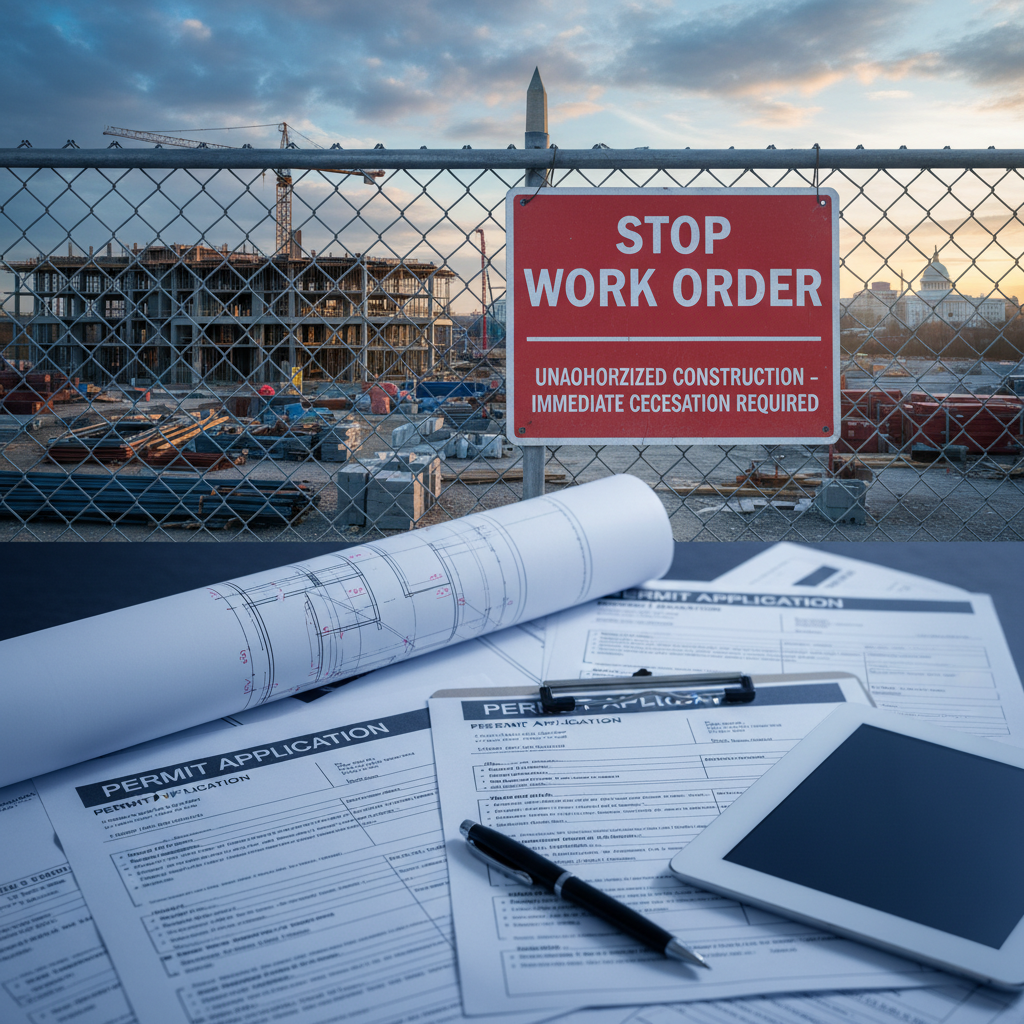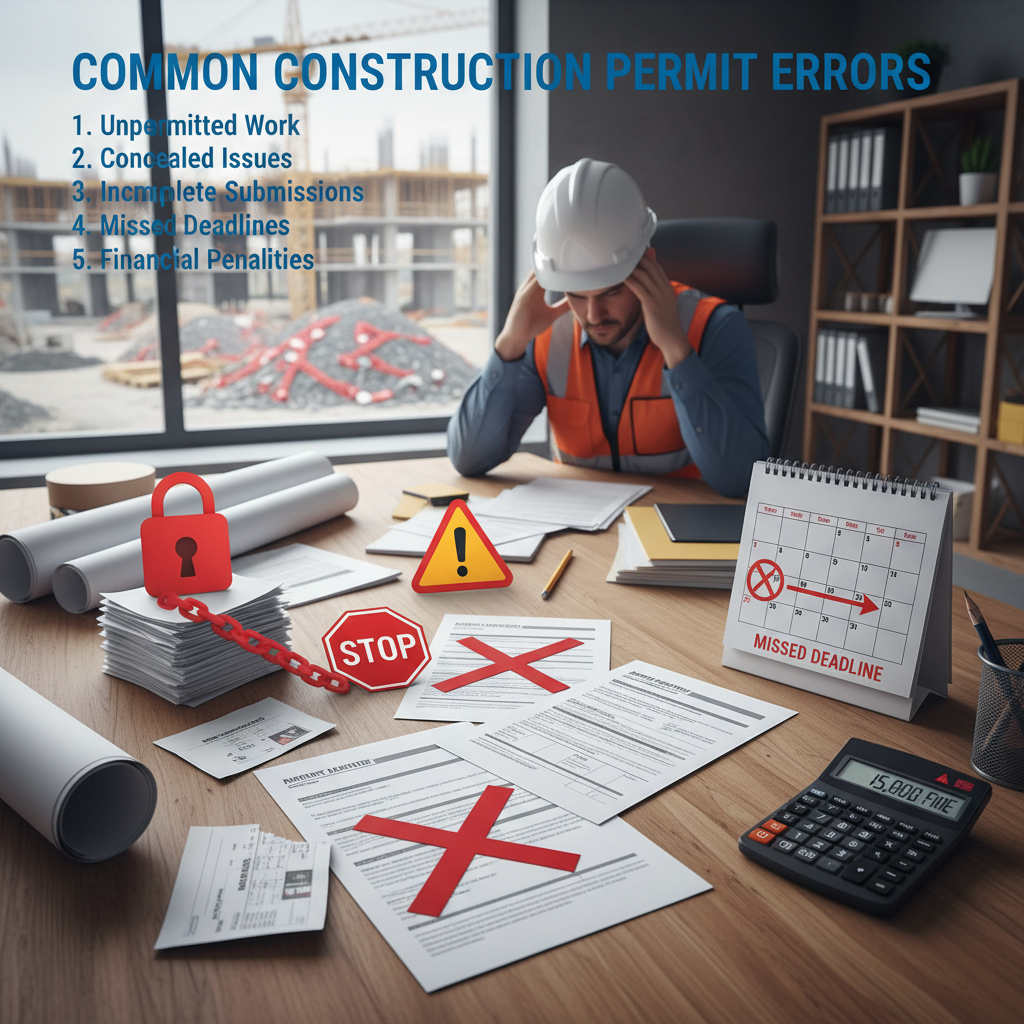How to Get a Permit After Construction Already Started in DC: Emergency Action Plan
You've already started construction. The work is underway. Then you realize, or someone tells you, that you need a permit. Your heart sinks. What happens now?
D.C. is a serious issue. But it's not necessarily a project killer. Thousands of property owners, contractors, and developers face this exact situation every year. The key is acting quickly and strategically.
This guide walks you through the exact steps to get retroactive permit approval in DC, minimize penalties, avoid stop work orders, and keep your project on track. We've helped dozens of clients navigate this scenario successfully.
The longer you wait, the worse it gets. The sooner you act, the better your outcome.
Don't navigate this alone. Schedule your free emergency permit consultation: (202) 729-8272
Why This Happens (And Why It's More Common Than You Think)
Construction starts without permits more often than you'd think. Even experienced contractors sometimes miss this. DC's permitting requirements are complex, and miscommunication happens.
Common reasons include:
Miscommunication between contractor and owner
Misunderstanding of what requires a permit
Contractor assumed owner got the permit
Owner thought minor work didn't need a permit
Rushed timeline pressures
Contractor working on multiple projects simultaneously
The good news? It's fixable. But timing matters.
Here's what's at stake if you don't act:
Stop Work Orders - DOB can issue an immediate halt. All work must stop. Fines accumulate daily. Your project timeline gets destroyed.
Financial Penalties - Fines start at $1,000 per day and can exceed $ 10,000 for multiple-discipline violations. Add retroactive permit fees and potential legal costs.
Forced Reconstruction - If work doesn't meet code, you may need to tear it down. Extremely expensive. Massive timeline delays. Potential loss of investment.
Insurance & Financing Issues - Insurance may not cover unpermitted work. Lenders may refuse to finance. Property value impacts. Resale complications.
Personal Liability - Both contractor and owner can face liability. Potential legal action.
Acting now prevents all of these scenarios.
Your 7-Step Emergency Action Plan
Seven Step Action Plan
Step 1: Stop Work Immediately (Do This Today)
Stop all construction work TODAY. Do not continue work while figuring this out. Continuing work = compounding violations.
Why? Every day of unpermitted work means additional fines. DOB can issue a stop work order at any time. Stopping shows good faith to DOB.
Action items:
Notify contractor to halt work immediately
Document what's been completed
Take photos of the current state
Gather all work documentation
Step 2: Gather All Documentation (Within 24 Hours)
Collect everything you have:
Construction plans and drawings
Contractor information and licenses
Scope of work description
Timeline of when work started
Budget and cost estimates
Any communications about the project
Photos of work completed
Building and site information
DOB will ask for all of this. Complete documentation equals faster approval. It also shows you're organized and serious.
Pro tip: The more documentation you have, the faster DOB can review and approve.
Step 3: Determine What Permit Type You Need (Within 48 Hours)
Consider:
Type of work (renovation, addition, repair, etc.)
Scope of work (electrical, plumbing, structural, etc.)
Building type (residential, commercial, historic, etc.)
Project cost
Whether it affects building systems
Common permit types for retroactive situations:
Building permit (most common)
Electrical permit
Plumbing permit
HVAC permit
Combination permits
Different permits require different documentation. Wrong permit type equals delays. Correct permit type equals faster approval.
If unsure, contact DOB or hire a permit expediter to determine the right permit type.
Step 4: Contact DOB Immediately (Within 48-72 Hours)
Call DOB: (202) 442-4623
Explain your situation honestly. Ask about the retroactive permit process. Ask about penalties and fines. Get specific requirements in writing.
Here's what to say:
"We have a construction project that started before we obtained the necessary permit. We want to get into compliance immediately. What's the process for retroactive permitting?"
What to expect:
DOB will explain requirements
They may ask for documentation
They'll explain the penalty structure
They may schedule an inspection
Important: Be honest and proactive. DOB respects contractors and owners who come forward voluntarily.
Step 5: Prepare Retroactive Permit Application (Within 1 Week)
You'll need:
Completed permit application
Detailed plans showing work completed
Code compliance documentation
Structural engineer certification (if structural work)
Electrical and plumbing plans (if applicable)
Proof of contractor licensing
Proof of insurance
Key consideration: Your application must show work ALREADY COMPLETED. Plans must match actual work done. All work must be code-compliant.
If work doesn't meet code, you'll need to fix it before permit approval.
Step 6: Submit Application & Coordinate with DOB (1-2 Weeks)
Submit your complete application to DOB with all required documentation. Pay retroactive permit fees. Follow up with DOB on status. Respond immediately to any requests.
Timeline expectations:
Plan review: 2-4 weeks
Deficiency response: 1-2 weeks
Re-review: 1-2 weeks
Inspection: 1 week
Total timeline: 4-8 weeks (if no major issues)
Pro tip: Hiring a permit expediter at this stage can cut your timeline in half.
Step 7: Pass Inspection & Get Final Approval (2-4 Weeks)
DOB schedules an inspection. The inspector reviews your completed work and verifies code compliance. They'll issue approval or a deficiency notice.
If approved:
Get written permit approval
Your project can resume
No stop work order
Minimal penalties
If deficiencies exist:
Correct the issues
Schedule re-inspection
Get final approval
Once approved, your project is fully legal and compliant.
Common Mistakes That Make This Worse
Common Mistakes
Mistake #1: Continuing Construction
Every day of continued work means more fines. It increases DOB scrutiny and shows bad faith.
Fix: Stop work immediately.
Mistake #2: Hiding the Problem
DOB will find out eventually. Hiding it results in worse penalties and shows dishonesty.
Fix: Come forward voluntarily.
Mistake #3: Submitting Incomplete Applications
Incomplete applications delay approval by weeks. They require multiple resubmissions and frustrate DOB.
Fix: Submit complete documentation the first time.
Mistake #4: Not Responding to DOB Requests
DOB will reject your application. This restarts the entire process and adds weeks to your timeline.
Fix: Respond within 24 hours to all DOB requests.
Mistake #5: Assuming Work Meets Code
Unpermitted work often doesn't meet code. It may need expensive fixes. You can't get approval without fixes.
Fix: Have an engineer review work before submitting.
Mistake #6: Not Hiring Professional Help
DIY approach equals delays. Mistakes equal rejections. It costs more in the end.
Fix: Hire a permit expediter early.
How MCG Can Help You Navigate This
You're stressed. You're worried about fines. You're unsure what to do. You need someone who knows DOB, understands the process, and can move things forward quickly.
Here's what we do:
Step 1: Immediate Assessment
Review your situation
Determine permit type needed
Identify potential issues
Estimate timeline and costs
Step 2: Documentation Preparation
Gather all required documentation
Prepare complete application
Ensure plans match actual work
Verify code compliance
Step 3: DOB Coordination
Handle all DOB communication
Submit complete application
Respond to deficiency notices
Schedule inspections
Step 4: Problem Resolution
Identify code compliance issues
Coordinate with engineers and contractors
Get issues corrected
Resubmit for approval
Step 5: Final Approval
Coordinate final inspection
Ensure work passes inspection
Get written approval
Your project resumes
Why Choose MCG:
25+ years DC permitting experience
Direct relationships with DOB
We've handled hundreds of retroactive permits
Average timeline: 4-6 weeks (vs. 8-12 weeks DIY)
Minimize penalties through strategic approach
Real Example:
A contractor started a $500k renovation without permits. We got retroactive approval in 5 weeks. Without our help, it would have taken 12+ weeks and faced a stop work order.
Don't let this derail your project. Schedule your free emergency consultation today.
Frequently Asked Questions
Q: Will I Get Fined?
Possibly, but the amount depends on several factors:
How long construction was unpermitted
Type of work
Whether work meets code
Whether you come forward voluntarily
Voluntary disclosure typically results in lower penalties than if DOB discovers it.
Q: How Long Will This Take?
Typically 4-8 weeks if:
Application is complete
Work meets code
No major deficiencies
DOB doesn't have a backlog
With a permit expediter: 4-6 weeks
Without: 8-12 weeks
Q: Can I Continue Construction While Getting Permit?
No. You must stop work until the permit is approved. Continuing equals additional violations and fines.
Q: What If the Work Doesn't Meet Code?
You'll need to:
Correct the work to meet code
Have an engineer certify corrections
Resubmit for approval
Schedule re-inspection
This adds 2-4 weeks to your timeline.
Q: What If DOB Issues a Stop Work Order?
Don't panic. You can still get retroactive permit approval. However:
Fines may be higher
Timeline may be longer
You'll need to prove work is code-compliant
Q: Do I Need a Lawyer?
Not usually. A permit expediter can handle most situations. You only need a lawyer if:
DOB is threatening legal action
Significant code violations exist
Property damage occurred
Insurance disputes arise
Q: What About My Contractor's Liability?
That depends on your contract. Typically:
Contractor should have obtained the permit
You may have recourse against the contractor
Consult your contract and insurance
Conclusion
Starting construction without a permit is stressful. But it's fixable. The key is acting quickly, being honest with DOB, and following the right process.
Your action plan:
Stop work immediately
Gather documentation
Determine permit type
Contact DOB
Prepare application
Submit and coordinate
Pass inspection
The sooner you act, the better your outcome. Waiting only makes things worse.
You don't have to navigate this alone. MCG has helped dozens of contractors and property owners get retroactive permits approved quickly and with minimal penalties.
Schedule your free emergency consultation today: (202) 729-8272
Or email: sayhello@mcgpermits.com




